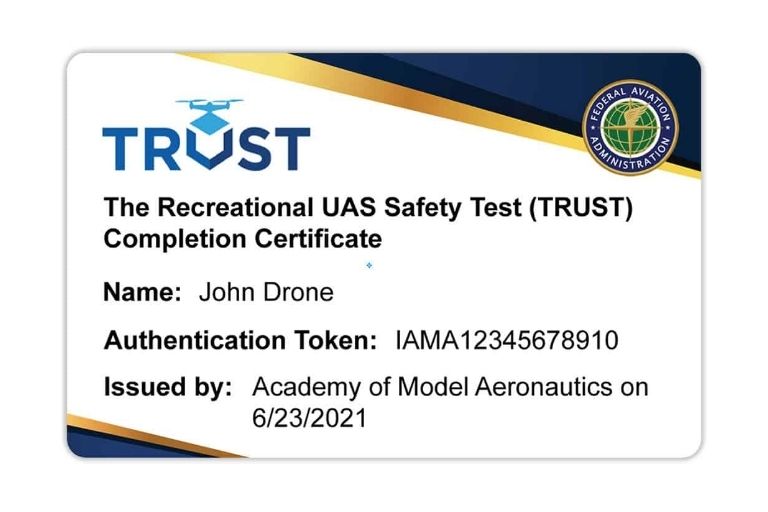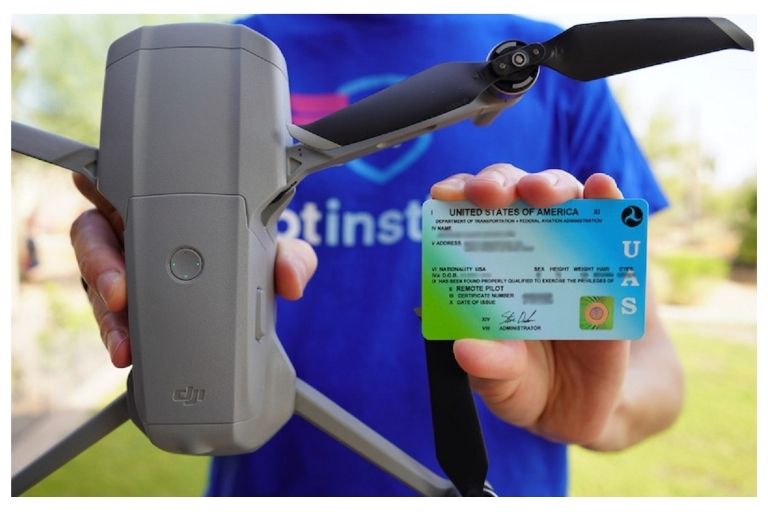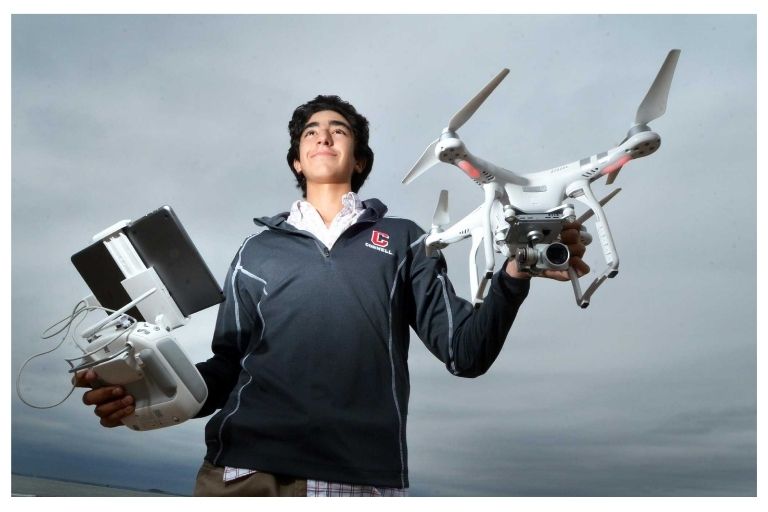If you want to turn your love for flying drones into a profitable business, getting an FAA Part 107 Certificate is essential. This guide will help you understand the steps and requirements to get drone license, giving you the confidence to navigate regulations and start exciting drone operations. Get ready to explore the world of drone licensing and open up endless opportunities in the sky.
What Is Drone License?
It is also known as a Part 107 license or commercial drone license, is essential for anyone looking to operate drones for commercial purposes. This certification demonstrates that the operator has the necessary knowledge and skills to fly drones safely and legally.
It involves passing a written exam administered by the Federal Aviation Administration (FAA) and meeting certain criteria regarding age, English proficiency, and security clearance.
By obtaining this certification, drone operators are equipped with the expertise to navigate complex airspace rules and regulations while ensuring the safety of both themselves and others around them.
When Should You Get A Drone Pilot License: Recreational Vs. Commercial Use
For those who are passionate about flying drones as a hobby, the idea of getting a drone pilot license might not seem necessary.
If you start using your drone for any form of commercial or work-related activities, such as aerial photography, videography, or surveying land – you’ll need to obtain a Part 107 drone license.
This distinction is crucial because without the proper licensing for commercial use, you risk running into legal issues and potential fines from regulatory authorities. Keep in mind is that commercial operators can still fly for recreation, but recreational pilots may not conduct commercial drone flights.
Recreational/ Hobbyist Rules—Flying For Fun
It is important to adhere to certain rules and regulations to ensure safety for yourself and others.
- All recreational hobbyists must follow is to take The Recreational UAS Safety Test (TRUST) required by the FAA. This test equips flyers with essential knowledge about safe flying practices and also helps in promoting responsible drone operation within the community.
- Always ensure that you are flying for fun and not for any commercial purposes. This distinction is crucial to avoid violating any aviation regulations.
- You must register your UAV with the FAA on the FAADroneZone website before taking flight. This helps track drone usage and also promotes responsible flying within legal frameworks.
- It is essential to fly within visual line-of-sight at all times, allowing you to maintain control and awareness of your drone’s surroundings.
- Following community-based safety guidelines and flying within the programming of a nationwide community-based organization (CBO) like the AMA can provide valuable resources and support for hobbyists looking to enhance their skills while prioritizing safety above all else.
- You must ensure your drone weighs under 55 lbs., unless certified by a community-based organization.
- It is crucial to never fly your drone near other aircraft or emergency response efforts as this could pose serious safety risks.
- Remember is that you must fly in Class G airspace, ensuring the safety of both yourself and others in the sky. If your aerial adventures require entering Class B, C, D or E controlled airspace, don’t forget to secure the necessary airspace authorization beforehand.
- To navigate through the process smoothly, consider exploring our LAANC authorization guide for valuable insights on obtaining permission efficiently.
- Remember that respecting emergency response efforts is non-negotiable during your recreational flights. Avoid flying near emergency situations as this could potentially hinder vital operations and jeopardize public safety.
Drone License vs. TRUST Certificate
When it comes to flying drones recreationally, one must decide between obtaining a drone license or a TRUST certificate. While a drone license may seem like the more official and professional choice, the TRUST certificate offers a simpler and more streamlined process for recreational flyers.
With the TRUST certificate, individuals can fly their drones without needing to pass an exam or undergo extensive training, making it a convenient option for those looking to get in the air quickly.
It is important to note that when flying recreationally, having your TRUST certificate on you at all times is essential. This adds an extra layer of responsibility and accountability for drone operators.

Part 107 Drone License—For Commercial Use
It is essential to remember that along with the freedom comes responsibility – as a certified pilot, you must adhere to all FAA regulations and safety guidelines.
- The requirement is to hold a Remote Pilot Certificate issued by the FAA, which entails passing a rigorous knowledge test.
- Registering your UAV with the FAA is mandatory for commercial use.
- It is also important to note that your drone must weigh less than 55 pounds and can only fly in Class G airspace without special permission.
- It is mandating that you must keep your UAV within visual line-of-sight and fly at or below 400 feet, it’s essential to master the art of precise navigation and spatial awareness.
- The requirement to use anti-collision lighting to fly during civil twilight or evening adds another layer of complexity to the operation.
- Adhering to the limitation of flying at or under 100 mph ensures safety not only for other airspace users but also for your valuable equipment.
Part 61 Certificate—The Exception To The Rule
The Part 61 certificate is often considered the standard requirement for pilots, but there exists an exception that challenges this notion.
Crewed aircraft pilots are now required to complete a free online training course known as Part 107 small Unmanned Aircraft Systems (sUAS) ALC-451 available on the FAA FAASTeam website.
After completing the course, you need to fill out FAA Form 8710-13 for a remote pilot certificate. Confirm your identity and schedule a meeting with an FAA official to endorse your form.
How To Get Drone License?
To get a drone commercial license from the FAA, you’ll need to follow these steps:
- Aspiring drone pilots must meet the minimum age requirement of 16 set by the FAA to be eligible for a Part 107 license.
- The next step involves passing the Aeronautical Knowledge Test, a comprehensive exam that assesses an individual’s understanding of airspace regulations, weather patterns, emergency procedures, and other crucial aspects of aviation knowledge.
- After successfully passing the Aeronautical Knowledge Test, candidates can proceed to apply for and obtain their Remote Pilot Certificate from the FAA. This certificate serves as official documentation of one’s qualification to operate drones commercially under Part 107 regulations.
Once you have your Part 107 drone pilot license, you’ll also be required to:
- After obtaining your FAA Part 10 license, it is crucial to ensure that you maintain your drone registration and keep your license up to date. This not only demonstrates professionalism and compliance with regulations but also helps in building trust with clients and authorities.
- Remember that failing to renew your license or update your registration can lead to penalties and legal consequences.
- It is essential to be prepared to make available any required documentation to the FAA upon request. This includes keeping records of flights, maintenance logs, and any other relevant information that may be requested by the authorities.
- If you have your Part 107 license, you’ll also be required to report any accidents to the FAA. This accountability ensures transparency and promotes a culture of safety within the drone community.
- Before all flights, conducting a preflight inspection is crucial. This step helps in identifying any potential issues with the drone equipment or surroundings, ensuring a smoother and safer flight experience.

How Much Does It Cost To Get An FAA Drone Pilot License?
The cost of obtaining Part 107 certificate, involves several expenses.
- Aspiring drone pilots are required to pass the Part 107 test, which costs $175. This exam evaluates applicants on various topics related to safe drone operation and airspace regulations.
- Individuals must register their drones with the FAA at a cost of $5 per drone for a three-year period.
Beyond the Part 107 Drone License Cost
- When assessing the overall FAA drone license cost of obtaining it, is setting up a LLC. The average cost ranges from $150 to $200, making it a relatively small yet important investment for those looking to establish a more formal business structure for their drone operations.
- Many drone operators choose to insure their operations through companies that offer on-demand insurance services.
How Long Does It Take To Get An FAA Drone Pilot License?
Studying for the Aeronautical Knowledge Test is a crucial step in obtaining an FAA drone pilot license, commonly known as the Part 107 certification. The time it takes to prepare for this exam largely depends on your familiarity with aviation concepts and regulations.
For test prep, you have a lot of options ranging from online courses, textbooks, practice exams, and even in-person training sessions. The FAA also provides a free Part 107 test study guide on its website, which can be a valuable resource in your preparation journey.
After passing the FAA drone pilot test, aspiring pilots often wonder how long it will take to receive their official license. The FAA anticipates that it will take six to eight weeks to issue a permanent remote pilot certificate after successfully passing the exam.
What Do People Use Their FAA Drone License For?
Individuals who obtain a FAA license often leverage their certification for various purposes beyond recreational use.
- In the construction industry, licensed drone pilots can conduct aerial surveys and inspections, enabling more efficient project management and progress tracking.
- Public safety agencies utilize drones equipped with cameras and thermal imaging technology for search and rescue missions, accident investigations, and disaster response efforts.
- Filmmakers and content creators harness the capabilities of drones to capture stunning aerial shots that enhance the visual storytelling of their projects.
- In agriculture, drone pilots play a crucial role in modernizing farming practices through precision agriculture techniques. By using drones to assess crop health, monitor irrigation systems, and analyze field data from above, farmers can optimize their operations for increased productivity and sustainability.
- Search and rescue missions benefit from drones equipped with thermal imaging cameras, enabling responders to locate missing persons in challenging terrain more quickly and effectively than traditional methods.
How Much Money Can I Make With An FAA Drone License?
The potential for earning ranges widely depending on various factors.
- Salaries can vary greatly depending on the type of work and employer you choose. On average, drone pilots with an FAA license can earn anywhere from $33,000 to $79,000 a year.
- By offering drone services to clients, you can earn a lucrative income through various projects. Depending on the type and complexity of the work, drone operators with an FAA license can charge anywhere from $200 to $300 per project.
- You can also make money with drone by starting your own drone business, profits will be based on the costs of running your enterprise and the type of services you offer. Performing aerial photography and videography for real estate agents or capturing footage at events can yield substantial returns.

You’re Ready To Get Your Part 107 Drone License
Once you’ve made the commitment to obtain your Part 107 drone license, you’ve embarked on a journey that extends far beyond simply passing the test. Becoming a certified drone pilot entails the responsibility of comprehensively understanding the regulations and safety protocols associated with operating a drone.
It is not just about obtaining the license; it’s about internalizing the information to ensure safe, legal, and proficient flight operations. This knowledge equips you with the ability to navigate airspace restrictions, respect privacy laws, and conduct flights without endangering others or compromising airspace security.
Final Words
Getting an FAA Part 107 drone license is important for those who want to fly drones commercially in the US. By following the steps in this article, aspiring commercial drone pilots can easily get certified. Knowing the rules for flying drones for fun, getting a Part 107 license for commercial use, and maybe getting a Part 61 certificate are all important for becoming a legal drone pilot.
Frequently Asked Questions
How Long Does it Take to Study for the Part 107 exam?
The time it takes to study for the Part 107 exam varies depending on your prior knowledge and study habits, but most people spend 2-4 weeks preparing.
What is the Format of the Part 107 Test?
The Part 107 test is a multiple-choice exam administered electronically at an FAA-approved testing center.
How many Questions are on the Part 107 Test?
The Part 107 test consists of 60 multiple-choice questions.
- Can I Take My Drone On A Plane? | 2024 - July 24, 2024
- Emergency Response Drones | Aerial Emergency Response - July 23, 2024
- What Is A Drone? | Features, Types & History - July 17, 2024

